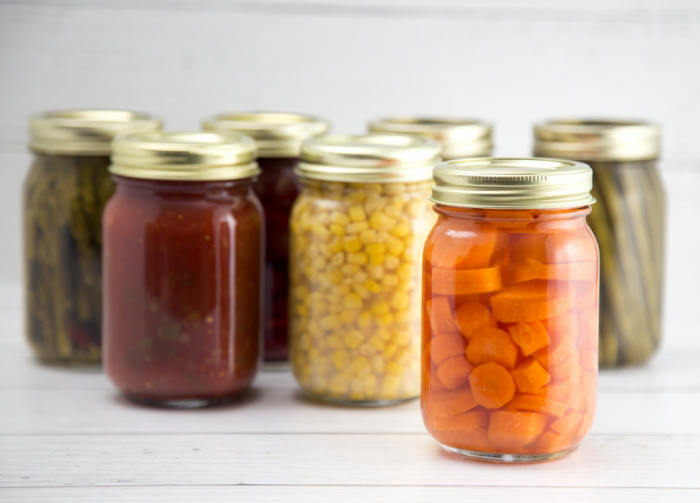
Today, I want to share my tips on storing food safely. I’m very concerned with what I see on Facebook and many blogs concerning food safety. Here’s the deal: We can’t afford to waste our precious dollars on the goods we buy to feed our family if we can’t store them properly.
You may have a different opinion, and I respect that. I have been canning food for over 50 years, and even so, Mark and I went several years ago to get our Master Canning Preserver Certificates.
Things change, and canning has had to change because food grown now is less acidic. Therefore, we have to adjust our canning habits. If you missed this post, please read it: Four Things That Are Not Safe To Can At Home.
My tips are easy to follow and will save you money in the long run. You have probably heard me say, “Buy right the first time.” To help you understand and deal with the necessary changes, I will walk you through my journey of storing food, and I’ve been doing it for 56 years.
I have been married for 56 years and have always had food storage. Some years were leaner than others, but I have always had food.
My mother taught me to make bread and to cook from scratch. Those are two valuable skills, and I appreciate the sewing skill that she taught me. If you have taught your family these skills and more, I applaud you. I do because you have taught them to be self-reliant.
Today I’m only talking about food, not water. You know my thoughts on storing water, please store at least 4 gallons per person daily. You may think that is way too much. It’s not, trust me on that one.
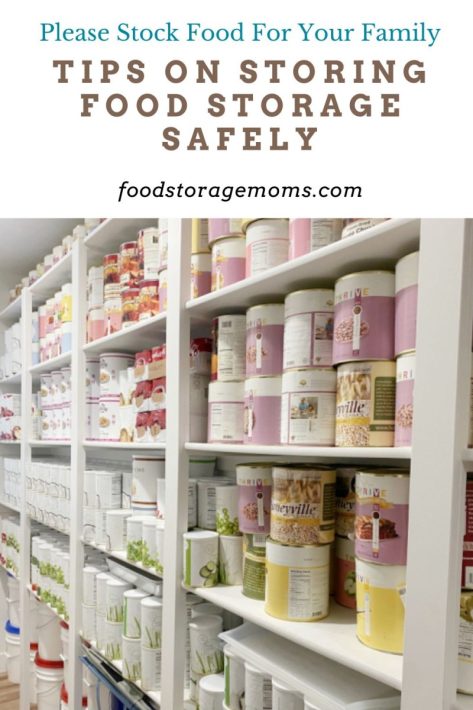
Tips On Storing Food Storage Safely
Shelving
When Mark and I were first married, we built some shelves ourselves. We were newbies, but we knew we needed to store food. We bought brackets, metal strips, and shelving.
Then, in our next home, we built shelves attached to the two-by-four studs in the basement. Those were perfect because I could see all the jars lined up that we had bottled. They were super strong and held up very well.
Fast-forward to now, and we have downsized to a much smaller home in Southern Utah. This house was perfect for the two of us and our two puppies. We even had room for guests. Thankfully, our family didn’t mind sleeping with buckets of wheat in the guest bedroom.
To stock our #10 cans, we purchased shelving from Costco online. The shelves in the store are not as sturdy. These are the ones I bought (then I added plastic sheets on the shelves) at Costco: Trinity 6-Tier Wire Shelving with Wheels.
We had wheels so we could move them easily if necessary. Those are 4-foot Bungee cords from Home Depot holding my cans in case of an earthquake.
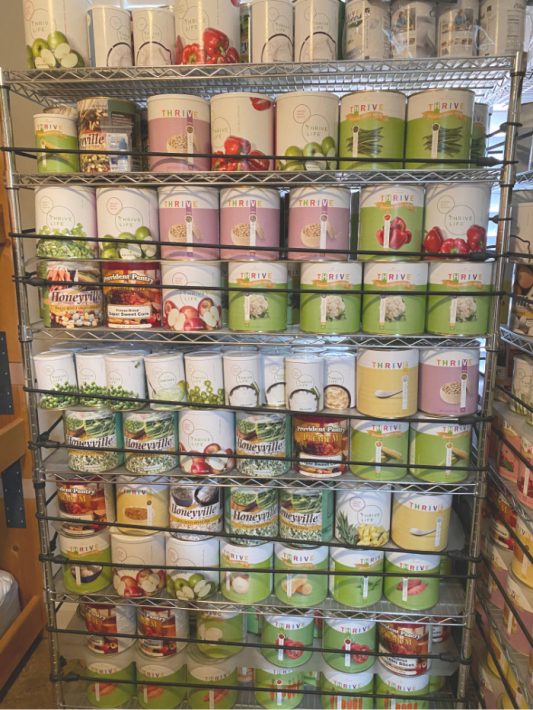
Updated: Our Home in Northern Utah
As you know, we have moved up north to be closer to family and friends. We now have a home that is 1000 square feet. This was trickier to store our food storage and emergency preps. I have had to let go of some things because of my oxygen issues.
We had custom shelves built to accommodate most of our food storage. They were supposed to be 2 feet deep, but the builder didn’t hear that somewhere along the line, so it is what it is.
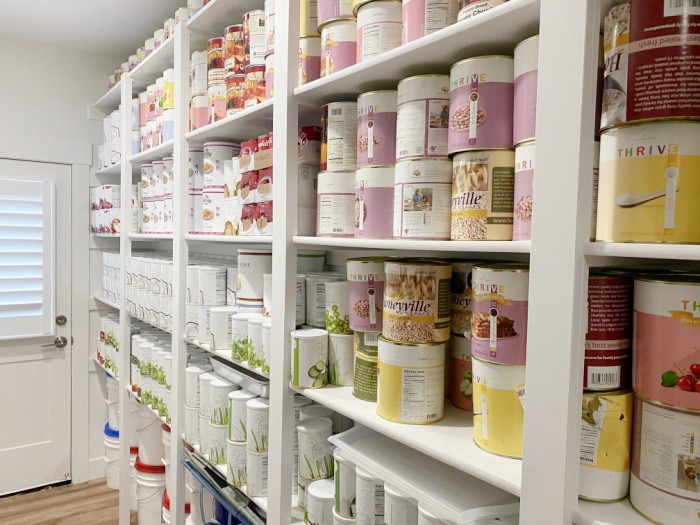
Buckets/Gamma Lids
This is how I store my Lehi Mills hard white wheat. I only buy wheat from them because they clean it at least six times, whereas most companies only clean their wheat two times.
My wheat grinders are pricey, so I can’t risk running cheap wheat through them. These Lehi Mills buckets are 6-gallon in size.
I store all my white bread flour and wheat with Red Gamma Lids. Everything in my house is color-coded.
I admit I may be a perfectionist—yep, I own it. I don’t put oxygen absorbers in my wheat and never use Mylar bags. I also don’t live where it is humid.
The wheat comes in these buckets, and I replace some lids with Red Gamma Lids. I pour the newer wheat into the buckets with the Red Lids, which is how I keep track of the freshest wheat.
Wheat-Hard White Wheat
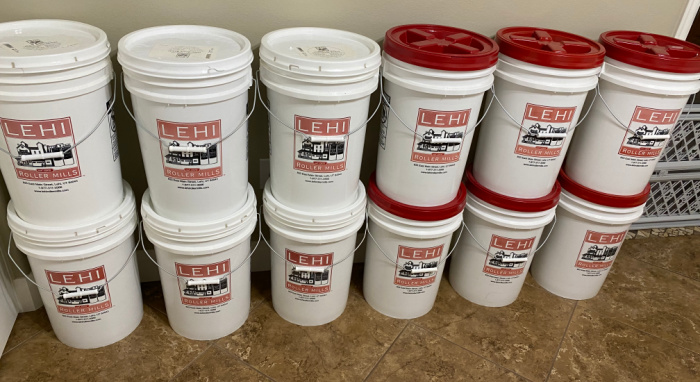
Containers
I love to buy Rubbermaid 8-quart and 12-quart commercial containers, like the ones below. They are airtight, and the lids are easy to remove and put back on. I use them because we used to live in the desert, and we had critters.
Yes, I have bug spray monthly; I have to. But I only spray the perimeter of my house. Mark and I can sleep at night knowing our food is protected from pests outside.
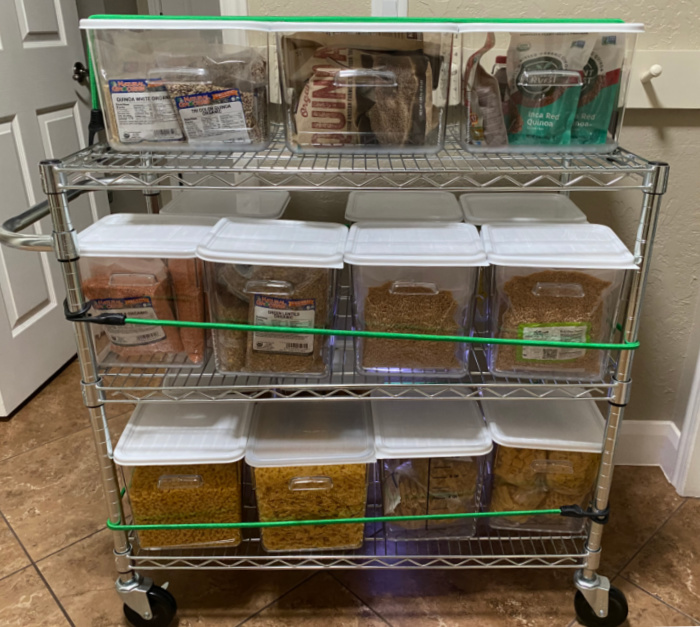
Canning Jars
These are mason jars made by Ball and Kerr. It’s been an easier year to get canning supplies, including lids, water bath canners, and pressure canners. Please note: Be careful what you read on the internet.
It is not SAFE to oven-can any food. The jars are not designed to have DRY HEAT, they may EXPLODE. In case you missed this post, Four Things That Are Not Safe To Can At Home
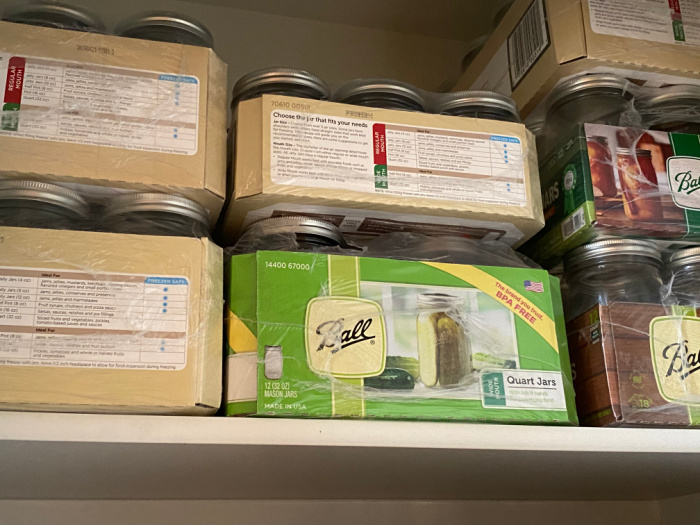
FoodSaver
FoodSavers are fantastic for food storage. I don’t use oxygen absorbers when I place food in my mason jars when using the FoodSaver Jar Sealer. I did call FoodSaver, and they said the old-style accessory hose is going away. It only works with the V2000 or V3000 series. The new accessory hose is now green and black, which is why people were having trouble getting the old style hose. The picture below shows what the old style looks like. Now we can use the Dicorain! Thanks to Ray for telling us about it.
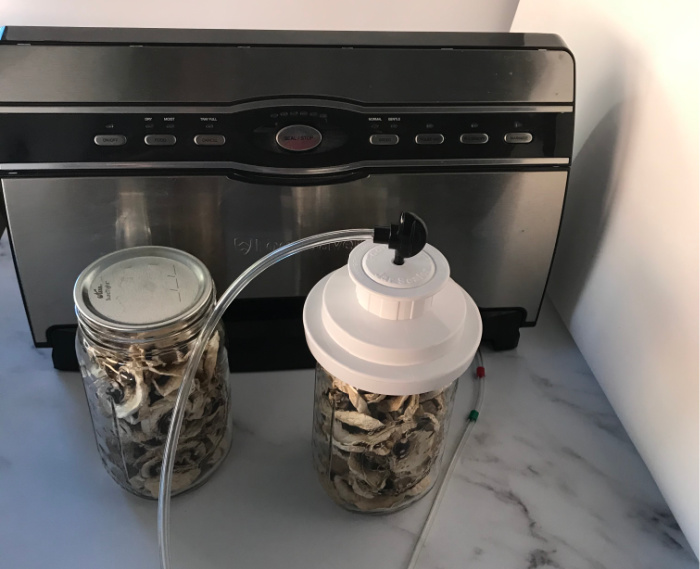
Now we can use the Dicorain! Thanks to Ray for telling us about it.
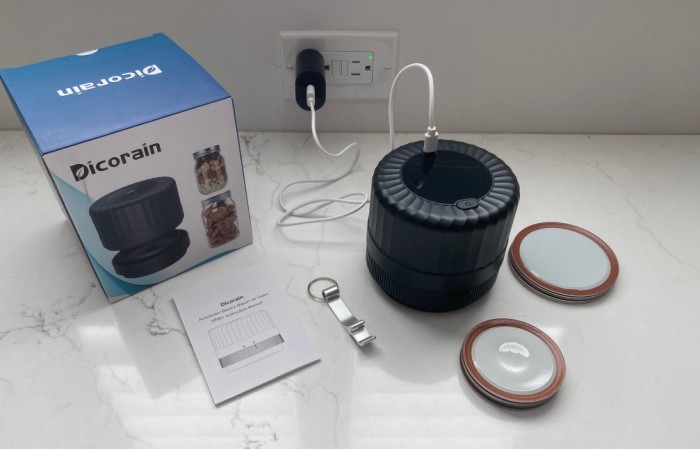
Long-Term Food Storage
My suggestion to all is to start with small cans of food, and when you have extra money, buy some commercially processed Freeze-Dried food in #10 cans with a shelf-life of at least 25 years stored inside your home.
Please buy one #10 can a month. Since the prices have skyrocketed this year, I advise waiting until they are not so high to continue your long-term food storage efforts. Here is a post you should read: Canned Foods I Highly Recommend You Store (these are short-term). Another option is to sign up for their newsletters and watch for discounts.
Dehydrating Food
Having a dehydrator is awesome for dehydrating your food. Mark and I took classes to get our USDA Master Canning and Preserving Certificate. We have both been canning together for 56 years or so.
But I wanted to know if there were changes in the canning world. Yes, indeed, there are changes. Our food has changed. It’s less acidic, so we have to make a few changes to our old canning ways.
We learned in class that the food we water bath, pressure can, or dehydrate ourselves has a shelf-life of one year. Yes, I have eaten some home-canned peaches that are 2-3 years old.
I get it. But it’s best if used within one year. So there you have it.
I have an Excalibur Dehydrator, but I have friends who have a Nesco and love theirs. Please get one that fits your budget. You will never waste food again. You can dehydrate leftover fruits and vegetables for snacks or soups.
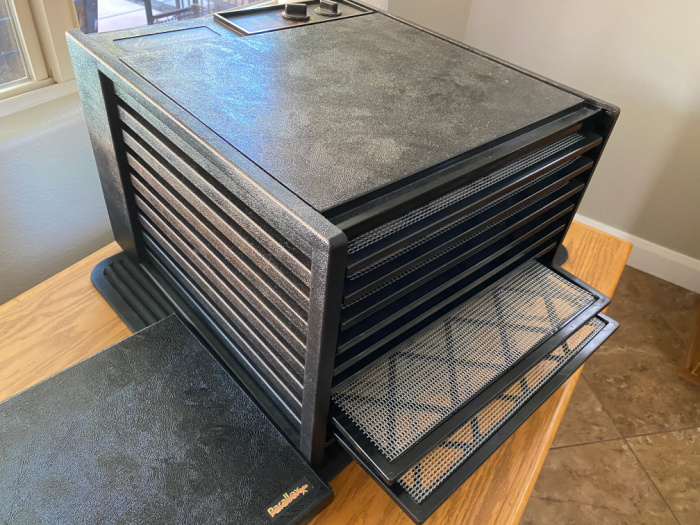
Food Storage Types
Freeze-Dried Food:
Let me explain freeze-dried food in a nutshell. The first step is freezing, followed by placing the frozen food in a vacuum chamber under low heat.
The third step starts when the frozen water crystals evaporate directly from ice to vapor, a process called sublimation.
What’s nice about freeze-dried food is that, depending on the manufacturer, it generally lasts longer in your storage stash. Please always look at the cans and see the shelf life listed.
You can eat the food directly out of the can, so meal preparation uses much less fuel. Freeze-dried foods usually have an open shelf life of 1-2 years.
Again, please look at the #10 can or the manufacturing company’s website for details.
Pros: You can eat it right out of the can. It uses less fuel because we can get by on most foods without cooking them. The bonus is that it has a longer shelf life than dehydrated food.
Cons: It’s more expensive.
Dehydrated Food:
Okay, most of us purchase dehydrated food every day. We buy cereal, spices, pasta, beans, baking mixes, etc. Dehydration is the process of removing water from the products.
The water is slowly removed from the food without actually cooking it. This is one of the most affordable, lightweight, and compact ways to purchase food for storage or everyday cooking.
We need to be aware of the term “dehydrated.” It generally takes longer to cook. Most items can’t just be “eaten” right out of the can—they’re too hard. This is fine for soups, stews, etc.
We must remember that dehydrated food does not typically last as long as freeze-dried food. Dehydrated food usually has a 5-8 year shelf life, while freeze-dried food usually has an OPEN shelf life of 6 months to 1 year. Please read the information provided by the companies you purchase from or produce the food.
Pros: It costs a lot less money.
Cons: It uses fuel to cook it and has a much shorter shelf life.
Mylar Bags/Oxygen Absorbers
I must set the record straight about not using Mylar bags and oxygen absorbers. About 12 years ago, I dry-canned food from a local church cannery in Salt Lake City, Utah, in #10 cans. Mark and I purchased the food there and were handed Oxygen absorbers. It was the first and last time I ever did this.
My daughter came, and we were all working together. Our mistake was that the volunteers at the cannery had zero experience using oxygen absorbers.
We dry-canned beans (full of large, inferior-quality rocks), dehydrated onions, carrots, and celery, and were so excited to be getting the food cheaper than, say, a commercial company.
Our problem was that the oxygen absorbers were open, warm, and used, so they would not work.
We were newbies and had no idea what we were doing. One year later, my daughter called and said, “Mom, I think these carrots are rancid.” So I opened my cans, one after another.
Yes, indeed, we wasted $1,200.00 on food we had planned to use for our entire family to have some food storage. All of the food had to be trashed.
At the time, I was teaching classes at Honeyville Grain in Salt Lake City, Utah. The company offered free courses to show people how to cook with food storage, and many outstanding teachers came and shared their expertise.
On one of the days I was teaching, an expert on oxygen absorbers was also teaching. What I learned that day changed my view forever on oxygen absorbers and Mylar bags.
There is a margin of error that can’t be missed when combining ounces of food with the different sizes of oxygen absorber cc’s. You don’t just throw an oxygen absorber into a Mylar bag or #10 can without first calculating the exact number (or more to be safe) of cc’s per ounce for the TYPE of food you put into #10 cans or Mylar bags.
MISTAKES can and will be made. This means different foods use different cc’s. Please be careful, or you may become sick from your processed food.
Storing Food Long Term
- How to Store Butter Long Term
- How to Store Cooking Oil Long-term
- How to Store Salt Long-Term & 9 Rational Reasons You Should
- Popcorn for Food Storage
Final Word
I hope you enjoyed today’s post on how to store food safely. We must stock food to keep our families safe. My gut tells me that there are still families out there that are not doing what they should be for one reason or another.
Do they love standing in line at the city and county buildings to get food after a disaster? Maybe they think the government will deliver food to their homes after a major disaster, I don’t know.
I have heard from local church leaders in my Southern Utah area that less than 10% of people are prepared to take care of their families after a disaster. Some leaders have asked me to come and teach some of the mothers in their congregation how to cook.
It was hard for me to say no because I love helping others. But I was surprised that in a congregation of 350-500, no one was close by to teach others to cook from scratch.
One leader sent me an email and asked, “How do I light the fire under these families in her church so they’ll be better prepared?” Wow, all I can say is, wow.
I feel like shouting from my rooftop, “People, get your act together!” Of course, I know several families in each area will be able to take care of themselves. At least I hope so. May God bless this world, Linda
Copyright Images: Various Fruits and Vegetables that have been Canned at Home AdobeStock_211841782 By Pamela_D_Mcadams
The post Tips On Storing Food Storage Safely appeared first on Food Storage Moms.
from Food Storage Moms
No comments:
Post a Comment